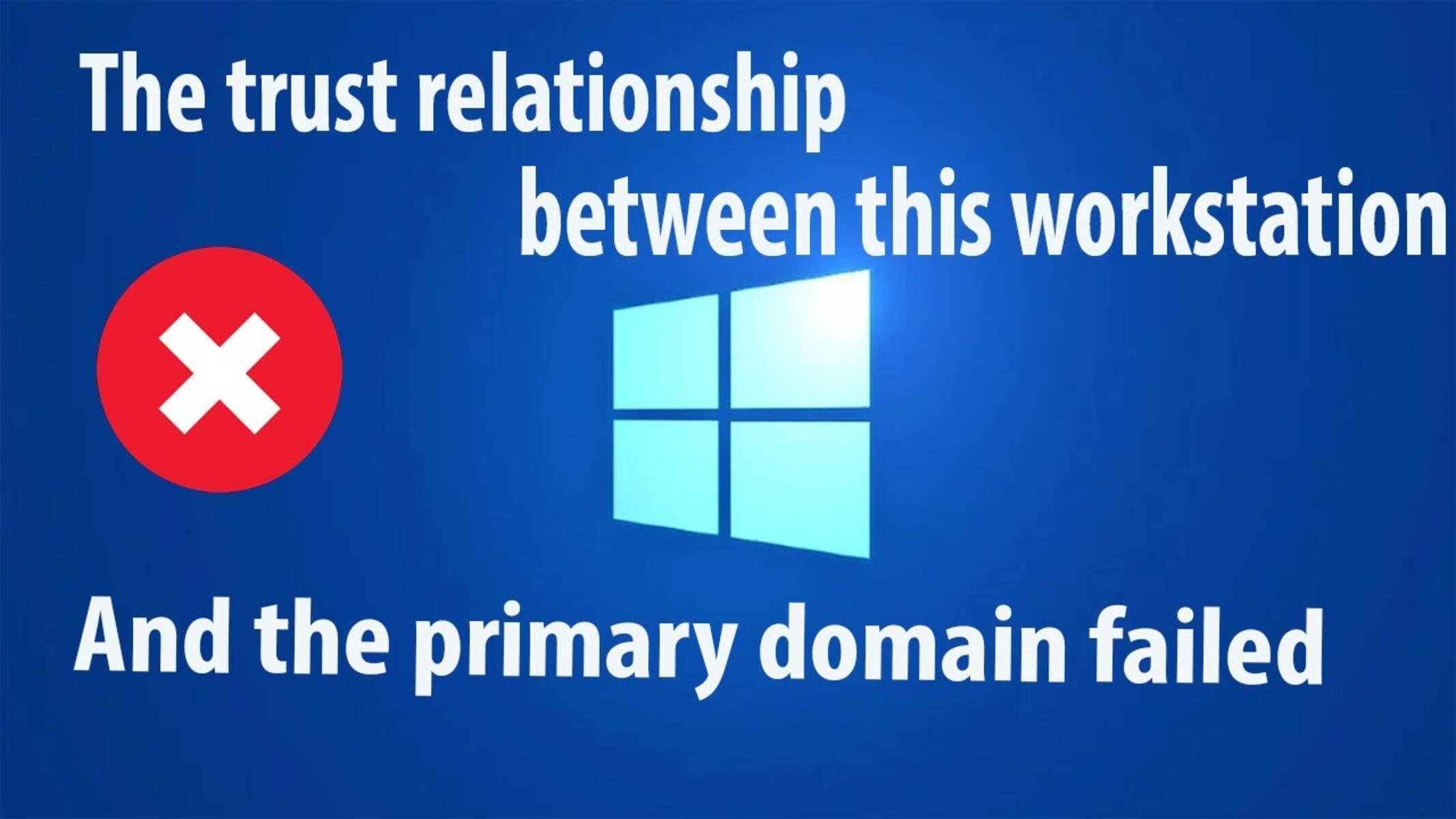Introduction
The trust relationship between a workstation and the primary domain is a crucial aspect of a secure and efficient network environment. It allows users to authenticate and access resources on the domain effectively. However, there are instances when this trust relationship can fail, resulting in login issues and restricted access to network resources.
When the trust relationship fails, it often indicates a synchronization problem between the computer account on the workstation and the domain controller. This can occur due to various reasons, including changes in the secure channel password, incorrect network configurations, or Active Directory replication issues.
In this article, we will explore the common symptoms and causes of a trust relationship failure and provide step-by-step solutions to fix it. Whether you’re an IT professional or an end-user experiencing this issue, the methods outlined here will help you restore the trust relationship and regain access to the primary domain.
It’s important to note that the methods mentioned in this article apply to Windows-based operating systems, such as Windows 10, Windows 8/8.1, and Windows 7. The specific steps may vary slightly depending on the version of Windows you are using, but the general principles remain the same.
By following the instructions and recommendations provided, you can troubleshoot and rectify trust relationship failures efficiently, minimizing downtime and ensuring smooth operations within your network environment.
What is the trust relationship between a workstation and the primary domain?
In a Windows domain environment, the trust relationship establishes a secure connection between a workstation and the primary domain. It allows users to authenticate their identity and access network resources based on their assigned permissions and policies. Essentially, the trust relationship ensures that the workstation and the domain can communicate and establish a level of mutual trust.
When a user logs into a workstation, the workstation verifies their credentials with the domain controller through the trust relationship. The workstation sends an authentication request, and the domain controller validates the user’s identity by comparing it with the stored user accounts and associated security policies.
The trust relationship can be thought of as a two-way street. On one hand, the workstation trusts the domain, allowing it to verify the user’s identity during logins and granting access to network resources. On the other hand, the domain trusts the workstation, validating its authenticity and authorizing the user’s access rights based on their group memberships and other configurations.
This trust relationship plays a vital role in maintaining a secure network environment. It enables organizations to enforce security policies, control access to sensitive data, and manage user permissions efficiently. By establishing trust between workstations and the primary domain, organizations can ensure that only authorized users can log in and access resources, reducing the risk of unauthorized access and data breaches.
The trust relationship is established through a process called the secure channel. The secure channel creates a secure communication path between the workstation and the domain controller, allowing them to exchange encryption keys and authenticate each other. This ensures that the communication between the workstation and the domain remains confidential and secure.
Understanding the trust relationship between a workstation and the primary domain is essential when it comes to troubleshooting trust relationship failures. By having a clear understanding of how this relationship functions, you can effectively diagnose and resolve any issues that may arise, restoring the trust and ensuring seamless access to network resources.
Symptoms of a trust relationship failure
When the trust relationship between a workstation and the primary domain fails, several symptoms may arise that indicate the issue. Recognizing these symptoms can help you identify trust-related problems and take appropriate measures to resolve them.
Here are some common symptoms of a trust relationship failure:
-
Failed login attempts: One of the most noticeable signs of a trust relationship failure is the inability to log into the workstation with domain credentials. Users may receive error messages indicating that their account or password is incorrect, even if they are entering the correct information. This is often a clear indication that the trust relationship between the workstation and the domain has been compromised.
-
Access denied to network resources: Another symptom of a trust relationship failure is restricted access to network resources. Users may encounter “Access Denied” errors when trying to access file shares, printers, or other network resources that they typically have permission to use. This can disrupt productivity and cause frustration for users who rely on these resources for their daily work.
-
Unexpected computer account behavior: Trust relationship failures can also manifest in the form of unexpected behavior related to the computer account. For example, the workstation may disappear from the Active Directory Users and Computers console or exhibit incorrect group memberships. These anomalies indicate a synchronization problem between the computer account on the workstation and the domain controller, resulting in a trust relationship failure.
-
Event log errors: Windows Event Logs can provide valuable insights into trust relationship failures. Look for entries related to authentication failures, secure channel issues, or Active Directory replication problems. The event logs may provide specific error codes or warnings that can help diagnose the trust-related issue.
-
Network connectivity issues: In some cases, trust relationship failures can be caused by network connectivity problems. If the workstation is unable to communicate with the domain controller, it may result in a failed trust relationship. Symptoms such as intermittent network connectivity, DNS resolution issues, or failure to ping the domain controller can indicate network-related trust problems.
It is important to note that these symptoms may vary depending on the specific circumstances and configurations of your network environment. However, if you notice any combination of the symptoms mentioned above, it is likely that a trust relationship failure has occurred.
In the next section, we will explore the common causes of trust relationship failures, which will help in understanding why these symptoms occur and guide us in resolving the issue.
Causes of a trust relationship failure
Trust relationship failures between a workstation and the primary domain can occur due to various reasons. Understanding the underlying causes is essential in effectively troubleshooting and resolving these issues. Here are some common causes of trust relationship failures:
-
Secure channel password mismatch: The secure channel is the mechanism through which a workstation and the domain controller communicate and establish trust. If the password of the secure channel on either side becomes out of sync, it can lead to a trust relationship failure. This can happen due to various reasons, such as a recent password change on one side that wasn’t propagated to the other.
-
Network configuration issues: Misconfigured network settings on the workstation or the domain controller can also result in trust relationship failures. Network configuration issues, such as incorrect DNS settings or incorrect IP address configurations, can hinder the communication between the workstation and the domain controller, leading to a failed trust relationship.
-
Active Directory replication problems: In cases where multiple domain controllers are involved, trust relationship failures can occur due to replication issues within the Active Directory. If updates to the computer account or secure channel password are not properly replicated across the domain controllers, inconsistencies can arise, causing trust-related problems.
-
Computer account corruption: Corruption or inconsistencies in the computer account on the workstation can also result in trust relationship failures. This can happen due to various reasons, such as software conflicts, malware infections, or hardware issues that affect the integrity of the computer account.
-
Domain controller unavailability: If the domain controller is unreachable or experiencing downtime, it can lead to trust relationship failures. Workstations rely on the domain controller for authentication and authorization, so when the domain controller is unavailable, the trust relationship cannot be established, resulting in login failures and restricted access to network resources.
It’s important to note that these causes are not exhaustive, and there could be other factors specific to your network environment that contribute to trust relationship failures. Diagnosing the exact cause requires thorough troubleshooting and analysis of the system and network configurations.
Now that we have identified the common causes of trust relationship failures, let’s move on to the next section, where we will explore the steps to fix the trust relationship between a workstation and the primary domain.
Steps to fix the trust relationship between a workstation and the primary domain
When faced with a trust relationship failure between a workstation and the primary domain, there are several steps you can take to restore the trust and regain access to network resources. Here is a step-by-step guide to fix the trust relationship:
-
Method 1: Reset the computer account password: This method involves resetting the password of the computer account on the domain controller. Through this process, the secure channel password is synchronized, restoring the trust relationship. This can be done using Active Directory Users and Computers or PowerShell commands.
-
Method 2: Remove and rejoin the workstation to the domain: In some cases, removing the workstation from the domain and then rejoining it can resolve trust relationship failures. This method creates a new trust relationship between the workstation and the domain, bypassing any synchronization or corruption issues in the previous relationship.
-
Method 3: Verify and reset the network connection settings: Ensure that the network settings on the workstation are correctly configured. Verify the DNS settings, IP address configuration, and network connectivity. Resetting the network settings can help establish a proper connection between the workstation and the domain controller, resolving trust-related issues caused by network configuration problems.
-
Method 4: Check and repair Active Directory replication issues: If your network environment involves multiple domain controllers, it is important to check for any replication issues within the Active Directory. Using the appropriate tools and commands, you can verify the replication status and address any inconsistencies that might be impacting the trust relationship.
-
Method 5: Use PowerShell commands to fix the trust relationship: PowerShell provides powerful commands to diagnose and fix trust relationship failures. Commands like Test-ComputerSecureChannel, Reset-ComputerMachinePassword, and Repair-ADComputerAccount can help identify and resolve trust-related issues efficiently.
It is important to note that the specific steps and commands may vary depending on your network environment and the version of Windows you are using. It’s recommended to consult the appropriate documentation or seek assistance from IT professionals to ensure the correct execution of the steps.
By following these steps and methods, you can troubleshoot and fix trust relationship failures, restoring the communication between the workstation and the primary domain. This will allow users to log in, authenticate, and access network resources with the necessary permissions and policies.
In the next section, we will conclude the article by summarizing the key points discussed and emphasizing the importance of maintaining a strong trust relationship within a network environment.
Method 1: Reset the computer account password
One of the common methods to fix a trust relationship failure between a workstation and the primary domain is to reset the password of the computer account associated with the workstation. By resetting the computer account password, you can synchronize the secure channel password and restore the trust relationship. Here’s how you can reset the computer account password:
-
On the domain controller, open the Active Directory Users and Computers Snap-in. You can access this tool by going to Start Menu > Administrative Tools > Active Directory Users and Computers.
-
Navigate to the Organizational Unit (OU) that contains the computer account for the affected workstation.
-
Find the computer account for the affected workstation in the list of accounts.
-
Right-click on the computer account and select “Reset Password”.
-
Enter a new password for the computer account. Make sure to choose a strong and complex password for security purposes.
-
Click “OK” to save the new password for the computer account.
-
Next, on the affected workstation, open an elevated Command Prompt. You can do this by right-clicking on the Start button and selecting “Command Prompt (Admin)”.
-
In the Command Prompt, type the following command:
netdom resetpwd /s:DomainController /ud:Domain\Administrator /PasswordD:AdministratorPassword -
Replace “DomainController” with the name of your domain controller, “Domain” with the name of your domain, “Administrator” with the name of a domain administrator account, and “AdministratorPassword” with the password of the domain administrator account.
-
Press Enter to execute the command. This command will initiate the password reset process between the workstation and the domain controller.
-
Restart the workstation to apply the changes.
After resetting the computer account password and executing the necessary commands, the secure channel password should be synchronized, and the trust relationship between the workstation and the primary domain should be restored. Users should be able to log in with their domain credentials and access network resources as usual.
It’s important to note that if there are multiple domain controllers in your network environment, the password reset process may take some time to propagate across all the domain controllers. Therefore, it’s essential to allow sufficient time for the synchronization to occur before assuming the trust relationship is fully restored.
Resetting the computer account password is an effective method to resolve trust relationship failures and should be a part of your troubleshooting process. In the next section, we will continue exploring other methods to fix trust relationship issues, providing alternative solutions for different scenarios.
Method 2: Remove and rejoin the workstation to the domain
In some cases, when a trust relationship failure occurs between a workstation and the primary domain, removing the workstation from the domain and then rejoining it can help resolve the issue. This method creates a fresh trust relationship between the workstation and the domain, bypassing any synchronization or corruption problems in the previous relationship. Here’s how you can remove and rejoin the workstation to the domain:
-
On the affected workstation, log in with a local administrator account that has the necessary permissions to remove the workstation from the domain.
-
Open the Control Panel by clicking on the Start menu and searching for “Control Panel”.
-
In the Control Panel, navigate to “System and Security” and then click on “System”.
-
Under the “Computer name, domain, and workgroup settings” section, click on “Change settings”.
-
In the System Properties window, go to the “Computer Name” tab and click on the “Change” button.
-
Select the option to join a workgroup instead of a domain and enter a temporary workgroup name.
-
Click “OK” to save the changes and restart the workstation.
-
After the workstation restarts, log in again with the local administrator account.
-
Repeat steps 2-5 to open the System Properties window and navigate to the “Computer Name” tab.
-
This time, select the option to join the workstation to a domain and enter the domain name that you want to rejoin.
-
Click “OK” to save the changes and provide the credentials of a domain administrator account when prompted.
-
Restart the workstation once more to complete the process.
By removing the workstation from the domain and rejoining it, you establish a fresh trust relationship with the primary domain. This process can help resolve trust relationship failures caused by synchronization issues, corruption, or other similar problems in the previous relationship.
However, it’s important to note that when you remove a workstation from the domain, you may lose some domain-specific settings and configurations. These include group policy settings, user profiles, and other domain-related customizations. Therefore, it’s advisable to back up any important data or settings before proceeding with this method.
Removing and rejoining the workstation to the domain is a reliable method to fix trust relationship failures. In the next section, we will explore additional methods to address trust-related issues, providing alternative solutions for different scenarios.
Method 3: Verify and reset the network connection settings
Trust relationship failures can sometimes occur due to misconfigured network connection settings on the workstation or the domain controller. Verifying and resetting these settings can help establish proper communication between the workstation and the domain controller, resolving trust-related issues. Here’s how you can verify and reset the network connection settings:
-
On the affected workstation, open the Control Panel by clicking on the Start menu and searching for “Control Panel”.
-
In the Control Panel, navigate to “Network and Internet” and then click on “Network and Sharing Center”.
-
In the Network and Sharing Center window, click on “Change adapter settings” on the left-hand panel.
-
Right-click on the network adapter that is connected to the domain network and select “Properties”.
-
Verify that the “Internet Protocol Version 4 (TCP/IPv4)” or “Internet Protocol Version 6 (TCP/IPv6)” is selected, depending on your network configuration.
-
If necessary, click on the corresponding protocol and then click on the “Properties” button.
-
Verify that the network settings, such as the IP address, subnet mask, default gateway, and DNS server addresses, are correctly configured for the domain network.
-
If any settings need to be modified, make the necessary changes and click “OK” to save the settings.
-
Restart the workstation to ensure that the changes take effect.
-
On the domain controller, also verify that the network settings are correctly configured, including the IP address and DNS server addresses.
-
If needed, make the necessary changes on the domain controller and restart it to apply the modifications.
By verifying and resetting the network connection settings, you can ensure that the workstation and the domain controller can communicate with each other effectively. This process can help resolve trust relationship failures caused by misconfigured network settings, ensuring a proper connection between the workstation and the primary domain.
It’s important to note that network-related trust issues can also be caused by network hardware or infrastructure problems. If the trust relationship failure persists even after verifying and resetting the network connection settings, it may be necessary to consult with your network administrator or IT support to investigate and address any underlying network issues.
Now that we have discussed the third method to fix trust relationship failures, let’s move on to explore additional methods and their respective solutions in the next section.
Method 4: Check and repair Active Directory replication issues
Trust relationship failures can sometimes be caused by replication issues within the Active Directory, especially in environments with multiple domain controllers. In such cases, checking and repairing Active Directory replication problems can help resolve trust-related issues. Here’s how you can check and repair Active Directory replication issues:
-
On one of the domain controllers, open the “Active Directory Users and Computers” tool. You can access this tool by going to Start Menu > Administrative Tools > Active Directory Users and Computers.
-
In the Active Directory Users and Computers window, right-click on the domain and select “Properties”.
-
Go to the “Domain Controllers” tab and verify the list of domain controllers associated with the domain.
-
Ensure that all listed domain controllers are accessible and functioning properly.
-
If a domain controller is not accessible or is experiencing issues, investigate and resolve the problem. This may involve checking the server’s network connectivity, validating DNS configurations, or addressing any specific errors or warnings related to the domain controller.
-
Once you have ensured that all domain controllers are accessible and functioning properly, check the replication status between the domain controllers.
-
You can use various tools and commands to check the replication status, such as “repadmin” or “dcdiag”. These tools provide insights into the replication health and help identify any replication errors or inconsistencies that may be impacting the trust relationship.
-
If any replication issues are detected, you can take steps to repair the replication. This may involve forcing replication between the domain controllers, resolving conflicts, or addressing any underlying issues that are preventing proper replication.
-
Monitor the replication process and verify that the replication errors or inconsistencies have been resolved.
By checking and repairing Active Directory replication issues, you can ensure that the changes made to the computer account or the secure channel password are replicated correctly across all the domain controllers. This helps maintain consistent and synchronized trust relationships, resolving trust-related problems between the workstations and the primary domain.
It is important to note that resolving replication issues can be a complex process, and it may require in-depth knowledge of Active Directory and network administration. If you are unsure about performing these steps, it is advisable to seek assistance from your network administrator or IT support team.
Now that we have discussed the fourth method to fix trust relationship failures, let’s move on to explore the final method and its solution in the next section.
Method 5: Use PowerShell commands to fix the trust relationship
PowerShell provides powerful commands that can be used to diagnose and fix trust relationship failures between a workstation and the primary domain. These commands offer a convenient and efficient way to address trust-related issues. Here’s how you can use PowerShell commands to fix the trust relationship:
-
On the affected workstation, open PowerShell as an administrator. You can do this by right-clicking on the Start button and selecting “Windows PowerShell (Admin)” or “Command Prompt (Admin)”.
-
Use the following command to test the secure channel and check the trust relationship status between the workstation and the domain controller:
Test-ComputerSecureChannel -
Review the output of the command. If it indicates that the trust relationship is broken, continue to the next step.
-
Use the following command to reset the secure channel password and restore the trust relationship:
Reset-ComputerMachinePassword -
Confirm the action when prompted, and wait for the command to complete.
-
Restart the workstation to ensure that the changes take effect.
-
After the restart, use the first command again (
Test-ComputerSecureChannel) to verify the status of the secure channel and ensure that the trust relationship has been restored.
Using PowerShell commands simplifies the process of fixing trust relationship failures by providing a direct and automated approach. The commands allow you to test the secure channel, reset the secure channel password, and validate the trust relationship status without requiring manual intervention or extensive configuration changes.
It’s important to note that PowerShell commands need to be executed with the appropriate administrative privileges, and you should be cautious when running PowerShell commands, especially those that modify system settings or configurations. Make sure to follow best practices and verify the impact of the commands before executing them.
By leveraging PowerShell commands, you can efficiently diagnose and fix trust relationship failures, ensuring that workstations can establish a trust relationship with the primary domain and access network resources promptly.
Now that we have explored the various methods to fix trust relationship failures, let’s summarize the key points discussed in the article in the next section.
Conclusion
Trust relationship failures between a workstation and the primary domain can disrupt productivity and hinder access to network resources. However, by understanding the causes and symptoms of these failures, as well as implementing the appropriate methods to fix them, you can quickly restore the trust relationship and regain seamless access to the primary domain.
In this article, we explored five effective methods to fix trust relationship failures:
-
Resetting the computer account password by synchronizing the secure channel.
-
Removing and rejoining the workstation to the domain to establish a fresh trust relationship.
-
Verifying and resetting the network connection settings to ensure proper communication between the workstation and the domain controller.
-
Checking and repairing Active Directory replication issues to maintain consistent trust relationships.
-
Using PowerShell commands to diagnose and fix trust relationship failures efficiently.
Depending on the specific situation and underlying cause of the trust relationship failure, you may need to utilize one or more of these methods to address the issue successfully.
Remember to follow best practices, consult relevant documentation, and involve IT professionals if necessary when implementing these methods. Troubleshooting and resolving trust relationship failures require careful attention to network configurations, security settings, and Active Directory management.
By taking proactive measures to maintain a strong trust relationship and promptly addressing any trust-related issues, you can ensure a secure and efficient network environment. Users will be able to log in, authenticate, and access network resources without disruption, allowing for continued productivity and seamless collaboration within the organization.
Implement the methods discussed in this article to effectively fix trust relationship failures and ensure the reliable operation of your workstations in the primary domain.

























